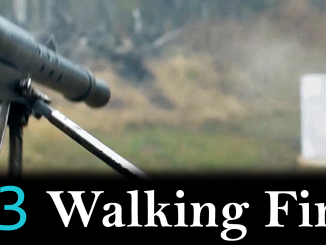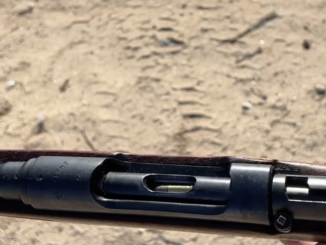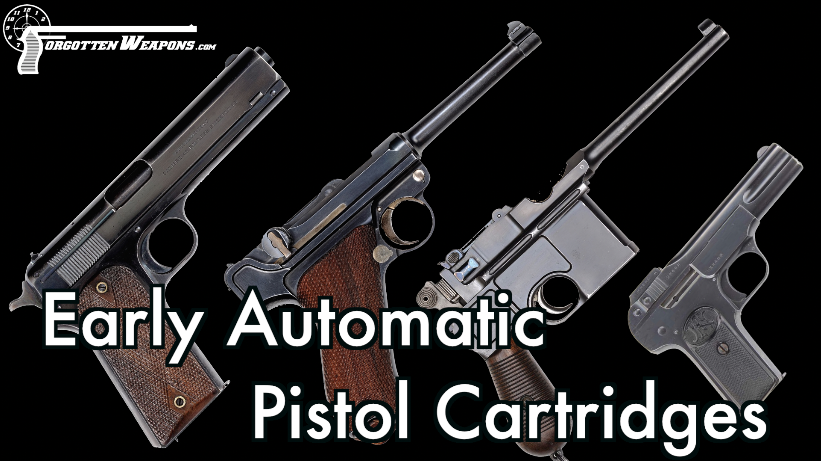The M1898 Rast & Gasser revolver was the last iteration of a series of revolvers, and was a standard Austro-Hungarian sidearm during WWI (despite the adoption of the Steyr M1912 selfloader). The M1898 an often underappreciated handgun, with a number of useful features and a very high standard of manufacturing. These features include use of the Abadie system to disconnect the hammer form the trigger when the loading gate is open, to allow much faster reloading, and a hinged sideplate for easy and complete access to the working parts. In addition, it has an 8-round cylinder, equal (or greater!) in capacity to any semiauto pistol in service during WWI and for some time thereafter.
Thanks to Larry for loaning my this example for the video!




Man, that is flat out awesome! I want one!! Thanks very much for posting this interesting video, Ian!
Incidentally, and anecdotally, the Austro-Hungarian K und K armed forces storm troops–analogous to the German storm troops and Italian Arditi among others–often carried older Gasser revolvers in the old “big bore” calibers along with the hand grenades, daggers, shovels, trench maces, extra sandbags, etc. etc. etc.
A timely and topical review what with the WWI centennial in full.
Well, sure it was popular, 11x36mm Gasser fired 20g (312 grains) bullet @ ~220-250m/s*, so quite respectable performances.
Depending on barrel length and powder load – from 1.9g (29 grains) grains in some Belgian commercial ammo, 2.3g (36 grains) in 1930s Yugoslavia commercial and 1890s Austrian ammo to 2.9g (45 grains!) in 1890s Montenegrin and 1870s Austrian made ammo. So obviously Austrians downloaded ammo at one moment.
Word of caution, firing those loads (except 29 grains one) from Belgian copies would not be advised, even original guns were slowly damaged (cylinder gap problem) with 45 grains loads…
I shot 1930s FOMU one from 1870/74 Gasser with 9″ barrel, and have to say that recoil is quite manageable, mostly due the gun weighting a ton (about 1.8kg loaded and Colt Walker sized). Soft lead bullets fully pancaked on steel target @ 25m.
From 1877 breakdown model with 5.1″ barrel it was more interesting, flash and smoke were quite impressive. Recoil was still OK, as that one was not light weight either (about 1.4kg even with 5-shot cylinder…)…
Municion has article about 11.3 Montenegrin cartridge:
http://www.municion.org/Montenegrin/Montenegrin.htm
I don’t know Spain, but understand that this cartridge:
-is comparable to .45 Long Colt
-may be crafted from .45-70 Gov’t cases
-has muzzle velocity 215m/s
http://www.hungariae.com/ has descriptions with photos of Gasser revolver in English (Gasser 1870, 1870/74, 1873, 1870/74 “Montenegrin”, 1880 “Montenegrin”), notice how big this revolver are – the Gasser 1870 has 235mm (9 and 1/4 inch) barrel.
215m/s is probably for 29grains loads from shorter barrels. With 35 grains powder and 312grains bullet we measured ~250m/s from 230mm (9″) barrel and ~230m/s from 130mm (5.1″).
Other way to make ammo is to use 8x50R Mannlicher or 7.62x54R brass, only slight resizing is needed. Alternately you can use slightly resized .410 plastic shotgun shells but keep powder load and bullet weight low (we shot that version with 25 grains powder and 250 grains bullet).
There is one danger about shooting Gassers, if you use 11x36mm for early Werndl cavalry carbine (and with old ammo it is always a risk) it will damage gun almost certainly, powder load for that one was 52 grains. Originals might stand it w/o catastrophic consequences but Belgian copies (especially cheaper ones) will not… Externally there is no way to tell a difference, internally Werndl carbine ammo lacks cardboard/felt spacer.
Other then 11x36mm there is also 11x29mm which had same 35 grains load as 11x36mm but did away with cardboard spacer, IIRC case was changed to prevent above mixup. Those are somewhat rare, as they were used only by Austrian army, while export guns were in 11x36mm.
There is also 11x32mm, but that is most probably only Belgian-made ammo, with 29 grains powder and cardboard spacer.
Fruwirth carbine used 11x36mm with 312/45 grains loads, which is one of reasons Montenegrins used that load even if it was hard on revolvers (as they had both Gassers and Fruwirth).
Great info, Bojan — thanks!
Thanks Larry for providing the test revolver! Very nice!
You are welcome! Ian got to fire it even before I did!! And no, don’t bother Ian. It’s not for sale and if I change my mind, Ian has first refusal.
Great video Ian and thanks for letting me be a part of it.
Operating system and takedown seems identical to the Swiss models 1878 & 1882 revolvers. The Swiss Model 1929 revolver continued the loading system, but lacked the hinged sideplate. Who was Abadie?
Surprised that such an efficient operating system wasn’t more widely adopted.
Abadie was a Belgian gunsmith, but I haven’t been able to find out very much about him. The loading gate system (which was also a safety mechanism, as it locked the hammer when the loading gate was open) first appeared in 1878, on a Portuguese service revolver:
http://tonnel-ufo.ru/eanglish/weapon/revolver-abadie-m-1878-m-1886.php
His name was Ismaël Isaac Abadie, he was a gunsmith and inventor (several firearms patents but other as well, e.g. screw propulsion for boats etc. Born June 20, 1820. And that’s about it 🙁
http://www.littlegun.be/ma_collection/belgique/be%20pqrstuvwxyz/a%20be%20simonis%20janssen%20et%20dumoulin%20gb.htm
http://www.gunauction.com/search/displayitem.cfm?itemnum=7104236
Belgian version of Rast-Gasser made after original Abadie pattent.. 🙂
Mr Abadie seems to be quite a character 🙂 Born in 1820, French, inhabitant of Paris (Rue de Moscou – which might explain a bit), took part in Commune de Paris tumults (http://en.wikipedia.org/wiki/Paris_Commune) in 1871, when he took active part in toppling the Napoleon III monument at Place Vendome on April 12, 1871. He was treated leniently – many fellow Communards were shot out of hand – mostly because he fled to Belgium long before the fateful military court session in 1872. There he lived in Liege and designed the revolvers. He was pardoned in May 1879.
Does it add much to his portrayal? I doubt – but it sure adds some life to his story 🙂
Wow, very interesting – where are you finding this info? Sounds like one of us should write a bio on him!
Does it have a spring behind the firing pin?
Yes, it does.
Here are pics of mine, got it for 40 euro as it has slightly bulged barrel (which did not prevent previous owned to shot .32 S&W Long regularly w/o any consequences…). Previous owned got it from an old man whose father captured it in WW1. Mechanically it is in perfect condition, it was fired a lot but it was also cleaned well.
http://miniaturesandcostumes.tumblr.com/post/62162082516/rast-gasser-model-1898-revolver
http://miniaturesandcostumes.tumblr.com/post/62162740055
“to shot .32 S&W Long regularly w/o any consequences”
Does is affect accuracy? The .32 S&W Long has .312 bullet diameter when 8mm Gasser has .320 bullet diameter.
Not particularly, I hit torso target @ 25m with every round, with grouping being not so great, but then rifling was also not so great on the gun I shot (not mine, I am not gonna shot gun with even slightly bulged barrel!). Full-lead bullets obviously managed to get enough “bite” into rifling to produce reasonable groups, I heard that jacketed .32 S&W Long (or .32 H&R Magnum, which is in milder loads in safe margin for Rast-Gasser) have problem with keyholing. IIRC best .32S&W Long to use is hollow base SWC, but it is rare to find here…
Here (Serbia) 8mm RG ammo costs about 2.5-3 euro per round if you manage to find it, you have to wait months to get it from arms dealer (as none keeps it in stock and it is next to impossible for private citizen to import it) so shooting .32 S&W Long is a reasonable alternative, considering reloading (other then shotguns) is prohibited…
Looks like a cousin of the Systeme Delvigne family tree, most famous for various Peiper and “Swiss” revolvers, and of course the Model 1895 Nagant.
“In addition, it has an 8-round cylinder, equal (or greater!) in capacity to any semiauto pistol in service during WWI and for some time thereafter.”
This is not true. Austrian Army used Roth-Krnka M.7 featuring 10-round magazine. French Army used Savage Model 1907 featuring 10-round magazine, however it was substitute handgun bought due to lack of service Model 1892 revolver.
And not forgetting the 10-rnd “Red Nine” broomhandle Mausers; the 32-rnd drum magazine on the Artillery Luger; the 20-rnd trench magazines issued with some Colt 1911s; the various 9-rnd Ruby type pistols used by the French; the Steyr M12 P16 machine-pistol. And, of course, any semi-auto issued with an 8-rnd detachable magazine is technically of 9-rnd (8+1) capacity, even if they weren’t usually carried that way…
(Pedantic? Us??) 😉
Anyhoo, very cool video Ian! It’d be great to see something on the old big-bore Gasser revolvers too, if you can get hold of one.
Okay, so I may not have thought that one completely through before clicking “post”. 🙂 You are correct, of course…but I think that the idea of the M1898 being reasonable equal in firepower to the other predominant handguns on the battlefield at the time stands.
Call it “as main service handgun” and you’re still correct. Yes, there were some higher capacity guns out there that got used as augmentation when production of the main service gun was lacking, none of the main combatant countries had adopted a high magazine capacity gun prior to the war (other than the Austrians themselves).
Interesting. I was aware of the extended-magazine version of the Steyr-Hahn M1912, which was used by Austrian aviators early on in WW1 before machine guns began to be mounted on scout aircraft, but I hadn’t been aware there was a selective-fire version.
I assume it had the usual high cyclic rate of most such weapons; I’d expect about 1,200 R/M, which would empty the magazine before you could let up on the trigger.
cheers
eon
As far as I’m aware they’re one and the same, Eon. One internet source quotes about 1,000 RPM in fully-automatic and states that less than 1,000 of them were made. (To be honest, the more I dig into these kinds of things, the more I realise how important primary sources are, so we probably shouldn’t take such information at face value.)
Nice gun, I really like it. I recall seeing previous model which was quite a bit taller from grip to barrel; this one is lot neater.
Thanks for video!
The Italian ‘Bodeo’ revolver is also designed with the ingenious Abadie system. It speeds reloading in non-swing out cylinder revolvers considerably.
Extremely well-designed and not bad looking either. This just may be my new favorite revolver! I can see why you and others want one for the personal collection. Now I do too!
Wow, thanks for posting this terrific video. It is so easy to forget that this was once a commonplace service revolver with the passage of time ( and many other interesting firearms ). I had read about the R & G M1898 many years ago ( although I’ve never had the privilege of personally handling one ) and had completely forgotten about its existence until now.
Loading gate safety works with an eccentric internal lug provided on axis rod of gate located at very near in front of axis of double action sear, as rotating backwards and first pushing the sear out of path of trigger contact and then placing over the sear as
arresting the hammer backward rotation. However, the hammer can be cocked before loading gate opening.
I gather that .32 H&R mag falls within the size, loading and pressure specs of the .32 Rast Gasser. can anyone confirm or refute this please.
.32 H&R cartridge (1984):
Parent case .32 S&W Long
Case type Rimmed, straight-walled
Bullet diameter .312 in (7.9 mm)
Neck diameter .337 in (8.6 mm)
Base diameter .337 in (8.6 mm)
Rim diameter .375 in (9.5 mm)
Rim thickness .055 in (1.4 mm)
Case length 1.075 in (27.3 mm)
Overall length 1.350 in (34.3 mm)
Primer type Small Pistol
8mm Gasser (1898):
Case type Rimmed, straight
Bullet diameter 8.11 mm (0.319 in)
Neck diameter 8.56 mm (0.337 in)
Base diameter 8.60 mm (0.339 in)
Rim diameter 9.68 mm (0.381 in)
Case length 27.00 mm (1.063 in)
Overall length 36.00 mm (1.417 in)
Filling smokeless powder
Filling weight 0.35 g (5.4 gr)
Ezell in Handguns of the World states that the 8mm Austrian Model 1898 Revolver cartridge is as follows;
case length; 27mm (case rimmed and straight-sided)
OAL (loaded round); 35.5mm
Bullet weight (jacketed); 7.8gm (~120 gr.)
MV; 245 m/s (~800 F/S)
This yields a ME of ~170 FPE.
I haven’t found any SAAMI figures for chamber pressure (CUP or PSI), etc., but my guess is that;
1. You could probably fire an 8mm M1898 round in a .32 Magnum chamber; the case dimensions seem about the same.
2. If you absentmindedly dropped a .32 Magnum round into a Gasser 8mm revolver, it would probably fit. And firing it would be an outstandingly bad idea, there being about a 100% differential in breech pressure, the wrong way.
Conclusion; if you have an 8mm Gasser and a .32 H&R Magnum both, don’t get the ammunition confused. You probably wouldn’t like the results.
Neither would the doctors at the ER.
cheers
eon
And on top of it, according to DC case length on 32H&R is .012″ longer. If that fits lengthwise in the chamber it will probably adds to firing pin ident, increasing piercing primer potential. Ouch!
Why to go thru all this if Fiocchi is offering proper round? BTW, this brings another question: are there any Italian handguns in this calibre?
I have seen something made on Bodeo frame with 8-shot cylinder, but I suspect it is actually Spanish made. Here:
http://www.mycity-military.com/imgs3/212275_66499149_DSCF3402.jpg
Quality of manufacture excludes home-made, timing is perfect and barrel rifling excelent. Caliber was first considered to be 8mm Mle.92 but it is actually 8mm RG.
Fiocchi ammunition in 8mm Gasser is next to impossible to find. I recently purchased a very nice Rast & Gasser revolver. Went through all 14 pages of a Google search for ammo and every vendor was “Out of Stock”. Some said back orders were ok, some did not. Listed on several sites to be notified when available. In the meantime, won a 25 round box on http://www.soldusa.com auction site and bought a full box of Fiocchi on another auction site. Will probably have to reload this cartridge. A mold for the 8mm Nambu can be had from RCBS and a custom sizer die can be ordered from Lee….depending on result of slugged barrel. Having correct brass will be nice……32 S&W Long brass may have to substitute. Any hand loading tips or ideas for 8mm Gasser is appreciated.
In milder loads it is safe to use, but jacketed bullets tend to keyhole.
.32 S&W Long with lead bullets (preferably hollow base SWC) works reasonably well even with relatively bad rifling. See my above post.
If you reload .32 H&R Magnum cases can be used to make it.
It seems that nearly all backward rolling gate revolvers after French 1873 Army had got used the advantage of Abadie system, mostly copying in various forms. Abadie lockwork needs a double action sear rotatably mounted on the hammer and works as pushing inside that sear out of reach of trigger rotation and also providing a stop on path of hammer fall even it had been cocked before the loading gate opening and
then released. Revolvers with double action sear mounted on the trigger like French Ml.74 seems could not be transmitted to that facility by cause of this adaptation needing radical changes in the lockwork.
One Youtube reply included a link to someone selling Pin fire reloading kits. I have never seen these befor http://hlebooks.com/pinfire/pin01.htm Heck I might need one just cause their neat.
could not help but notice it is a very quiet gun, at first it thought he was dry firing it!
Ian,
I have a Rast & Gasser revolver I would like to sell. Let me know if you are interseted and I will describe it in detail and send pictures.
Max
If you still have it, I’d be interested. You can find me on Gunboards under the same name.
Sorry; it’s been sold.
i read on Wikipédia that this revolver was manufactured chambered in 7.62mm nagant…does anybody have information on that?
2-23-2018
Hello And Good Evening To You:
I’ll get right to the point.
I have Written/Created an “Original” G.U.N.S. Slogan/Phrase.
Legally Protected.
Here it is:
G.U.N.S.
Good
Universal
Natural
Selection
Would You be interested in Owning My Slogan/Phrase?
If so, Please contact me: 830-331-9545
or
Send me an email to: greenehandmusic2@yahoo.com
And I Thank You for your time and consideration.
Allen Greene
P.S. I have a Trademark on my G.U.N.S. Slogan/Phrase.
Ian,
A friend of mine has one of these revolvers. It is serial number 1. It is very ornate. I would love to discuss this revolver with you.